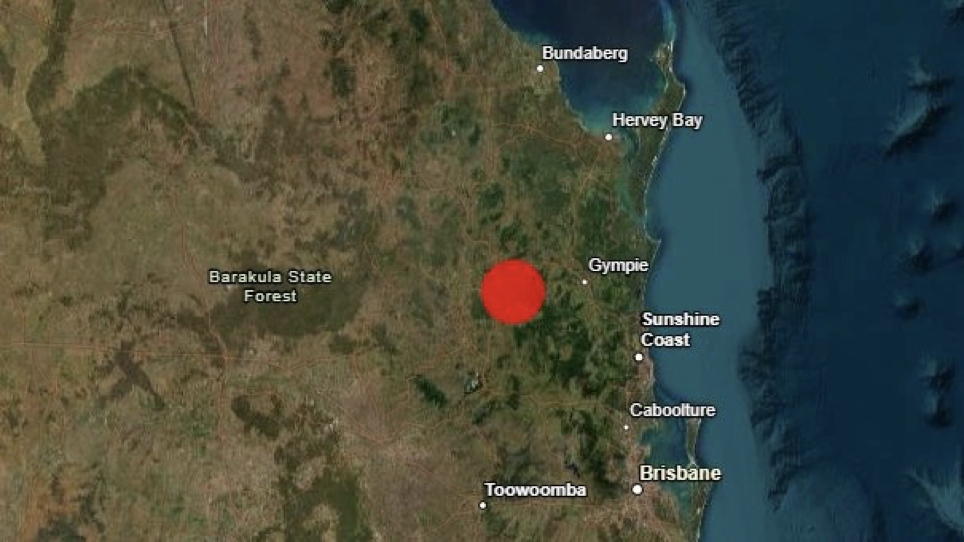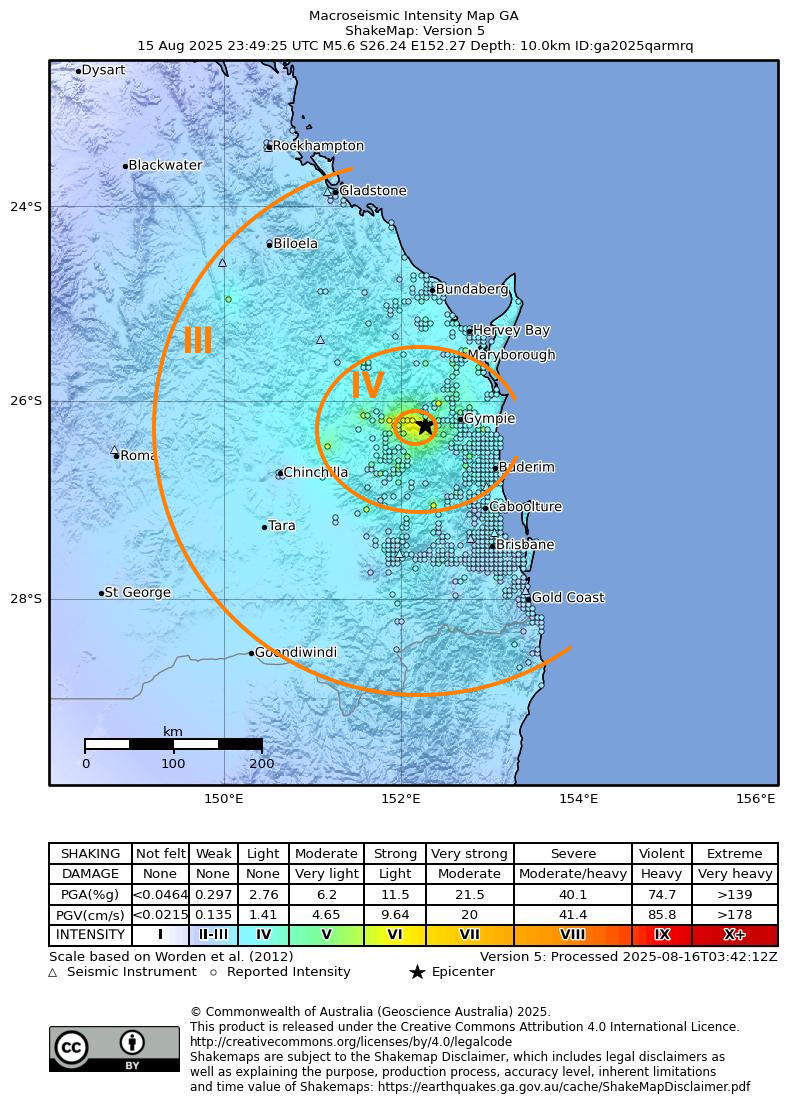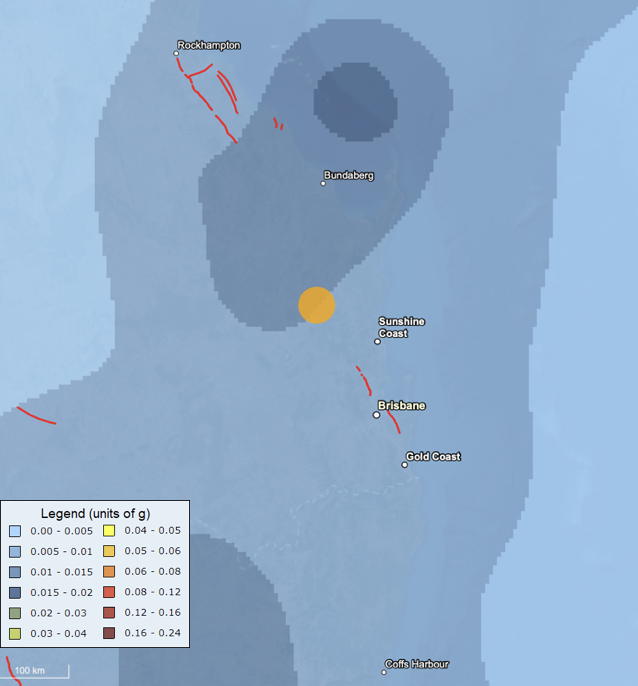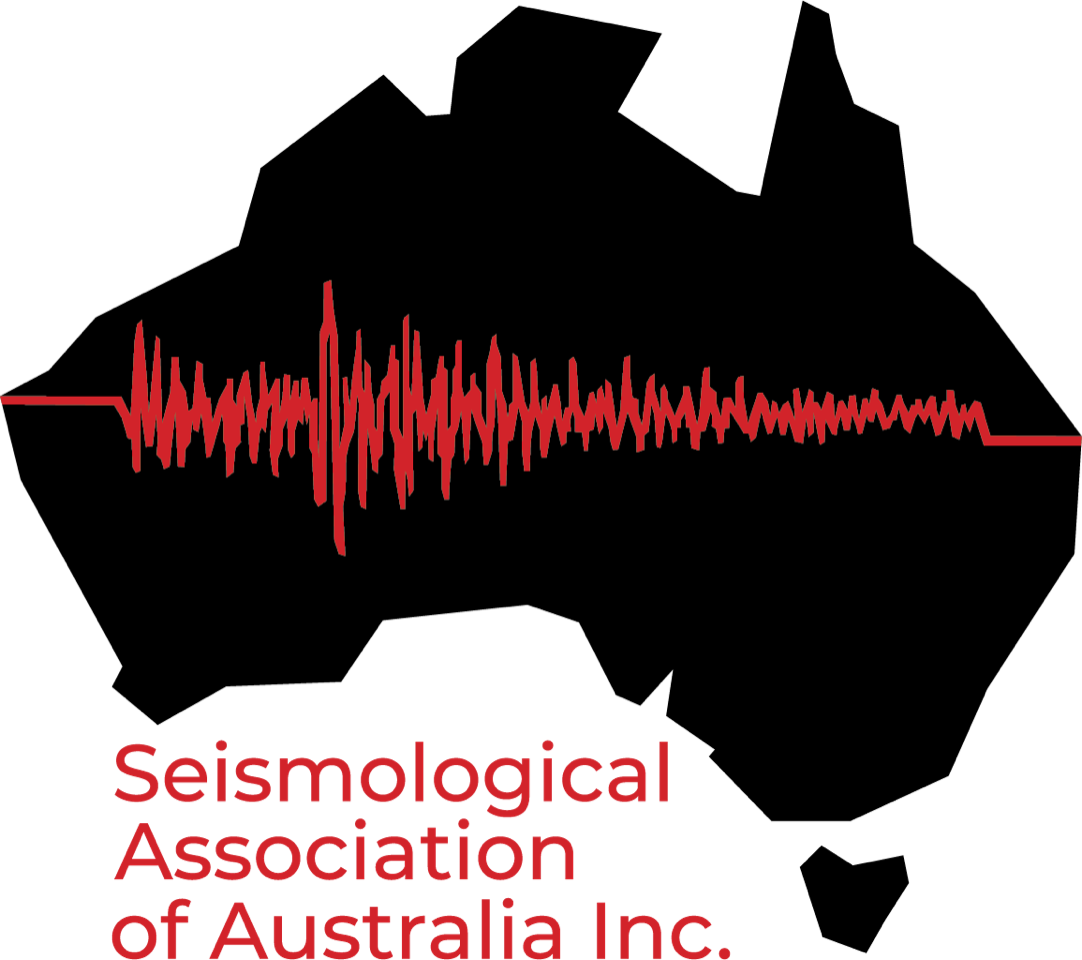What we know is that the magnitude was the same at ML5.6 as the 1989 Newcastle earthquake. The epicentre was in the Wrattens National Park about 135km northwest of Brisbane which accounts for the lack of damage. The felt radius is about 300km. The nearest seismograph was about 100km away so the focal depth, whilst shallow, is indeterminant.
Geoscience Australia reported the epicentre at -26.24, 152.27 with a horizontal uncertainty of ±5km The USGS location is at -26.46, 152.13 about 20km further south and 2s earlier. The GA epicentre is 135km northwest of Brisbane, at 9.49am on Saturday. GA measured a magnitude MLa of 5.6 and assigned a focal depth of 10km.
Danny Donald from Energex said crews investigated power outages near the earthquake’s epicentre. “In total, we’ve got around about 11,000 customers affected between the Fraser Coast, Burrum Heads, and Murgon,” he said. Power was returned to all customers by 12:30pm.
Queensland Rail said the north coast lines ending in Cairns were suspended until further notice to ensure track safety. Services on all Brisbane city lines were running at lower speeds due to the tremor, and trains were delayed by up to 15 minutes.

Figure 1 Geoscience Australia recorded an earthquake (the red dot) north of Brisbane on Saturday morning. Picture: Geoscience Australia
A straw poll of seismologists and family is interesting. Seismologist Col Lynam was at Sunnybank SE Brisbane approximately 185km SE of the epicentre and “did feel the M5.6 very notably on my swivel chair, roof noises and wobbles”. Fellow seismologist Mike Turnbull reports from Redbank Plains that “people in neighbouring suburbs reported feeling it very strongly (MM 4 to 5). My two daughters and I were out in the front courtyard. I was seated in a camp chair relaxed having a cup of tea and they were sitting on the paved floor cleaning a piece of furniture. Everything was quiet and we were just talking when my brother in Toowoomba messaged me and said he and everyone around him at a local soccer match had felt a very strong earthquake shake. We had heard and felt nothing, not a sniff. My nephew in Caloundra rang later. He was visiting a friend who said that at the time of the event he thought someone was trying to pull his chair from under him. It scared him badly once he realised what it was.
Another seismologist Ian Ripper and his wife resting at home in Toowong didn’t feel the earthquake. A family member normally in Brisbane answered my query: “I was at Mum’s in Maryborough and most definitely felt it! Probably lasted for less than 10 seconds. I was working on the laptop while lying on my bed. Whole house shuddered and I could feel the bed shuddering on the timber floor. Not enough to actually move anything or cause anything to fall over or off shelves. All the doors and windows were rattling, don’t recall any creaks or groans though and no apparent damage or cracks or anything of that nature. Seemed fairly consistent in intensity for the duration. Mum was downstairs in the garden and said she didn’t remember feeling any movement in the ground but heard the garage rollers doors nearby rattling. “

Figure 2 Felt area of the August earthquake near Brisbane (contours added to a map by GA).
Residents in Brisbane and the southeast flooded social media with reports of tremors. “My house began to noticeably shake/rock for no apparent reason,” one resident of Kelvin Grove is Brisbane’s out suburbs said.
“…. We just had an earthquake,” another person from Melaney, near the Sunshine Coast said. “I was still in bed and heard a deep rumble like a big truck going down the street, then the house – and bed – started to shake and the windows rattled.
Reports of the quake came in from Boondall, Oxley in Brisbane and Macleay Island near Moreton Bay, and in Gympie.
Trains servicing Varsity Lakes to Central on the Gold Coast were cancelled as a result of the “seismic activity”. All trains on the Translink network were also experiencing delays of up to 30 minutes shortly before 11am due to the quake.
Queensland Police said they were aware of the quake, but had not reported any “major damage or injury”.
ABC News
More than 24,000 people submitted “felt reports” to Geoscience Australia.
Michelle Salmon, a seismologist from Geoscience Australia, said it was the largest onshore quake in half a century, and the largest to hit Queensland at all since 2016, when a magnitude-5.8 event occurred off the coast of Bowen. She said Queensland was “the least seismically active state” in Australia. In this case tremors were felt as far south as Glen Innes and as far north as Rockhampton.
She said Saturday’s quake was actually slightly larger than Australia’s most famous earthquake, which hit Newcastle in 1989, killing 13 people.
“In this case we are lucky it wasn’t closer to any of the big towns along the coast,” she said.

Figure 3 The orange dot is the epicentre of the ML 5.6 August earthquake on the background of GA’s NSHA18 10% in 50 year probabilistic contours of pga. The red lines are interpreted neotectonic features. It managed to evade both.
Tremors felt in Kumbia.
Lucinda Ross in Kilkivan, east of the epicentre, said the house was “absolutely shaking and jolting” when the quake hit. She said the house shook for “about seven seconds” but nothing was damaged.
Eden Woodley and Oscar Middleton said they felt the tremor at Palm Beach on the southern Gold Coast. “I was sitting in a chair and just felt like my shoulders going back and forth,” she said.
Eden Woodley and Oscar Middleton felt the quake on the Gold Coast. Mr Middleton said he was sitting thinking ‘Am I hungover or am I imagining this?’ he said.
ABCNews
Geoscience Australia has detected four aftershocks following the weekend’s main quake, but seismologist Michelle Salmon said they were too weak to be documented.
“We’ve actually seen them on our seismometers, but we can’t publish them on the Geoscience Australia catalogue because they are too small for us to get really good locations to the standard that we require,” she said.
Geoscience Australia will deploy seismic rapid deployment kits to the Sunshine Coast to measure potential aftershocks. The kits are temporary devices used to measure seismic activity through sensors buried in the ground close to the quake’s epicentre. “We have a seismometer and we have an accelerometer,” Dr Salmon said.
“The seismometer is there to capture those really small events, and the accelerometers are for the bigger events. “So when it shakes too much and it overloads our seismometers, we can actually still capture the information.” Six of the devices will be deployed on the Sunshine Coast by Friday 22 August.
Summary
Since 1901 there have been 21 earthquake of magnitude 5 or more in Queensland, and 6 of them were of magnitude 5.5 or more. The largest known earthquake was that near Bundaberg in 1918, magnitude 6. The impact of this 2025 earthquake would have been more destructive had it occurred in a population centre or been larger. Very small aftershocks have been observed, too small to locate but another of equal size could also occur given this lack of appreciable aftershocks.
